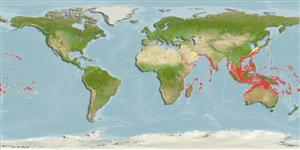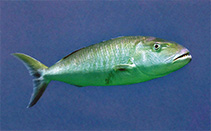Aprion virescens Valenciennes, 1830
Green jobfish
把你的觀察加入 Fish Watcher
| Native range | All suitable habitat | Point map | Year 2050 |

|
| This map was computer-generated and has not yet been reviewed. |
| Aprion virescens AquaMaps Data sources: GBIF OBIS |
Common names from other countries
分類 / Names 俗名 | 同種異名 | Catalog of Fishes(屬, 種) | ITIS | CoL | WoRMS | Cloffa
Teleostei > Eupercaria/misc (Various families in series Eupercaria) 鱸形目 (Various families in series Eupercaria) > Lutjanidae (Snappers) 笛鯛科 (Snappers) > Etelinae
Etymology: Aprion: Greek, a = without + Greek, prion = saw (Ref. 45335).
More on author: Valenciennes.
Etymology: Aprion: Greek, a = without + Greek, prion = saw (Ref. 45335).
More on author: Valenciennes.
Environment: milieu / climate zone / depth range / distribution range 生態學
分布 國家 | FAO區域 | 生態系 | 發現紀錄 | Point map | 簡介 | Faunafri
Indo-Pacific: East Africa to the Hawaiian Islands, north to southern Japan, south to Australia.
印度-太平洋: 東非到夏威夷群島, 北至日本南部, 南至澳洲。 也記錄自南非。 (參考文獻 5484)
印度-太平洋: 東非到夏威夷群島, 北至日本南部, 南至澳洲。 也記錄自南非。 (參考文獻 5484)
Length at first maturity / 大小 / 重量 / 年齡
Maturity: Lm 45.0, range 42 - 50 cm
Max length : 112 cm TL 雄魚/尚未辨別雌雄; (Ref. 7196); common length : 90.0 cm TL 雄魚/尚未辨別雌雄; (Ref. 5450); 最大體重: 15.4 kg (Ref. 40637); 最大年齡: 32 年 (Ref. 125573)
Max length : 112 cm TL 雄魚/尚未辨別雌雄; (Ref. 7196); common length : 90.0 cm TL 雄魚/尚未辨別雌雄; (Ref. 5450); 最大體重: 15.4 kg (Ref. 40637); 最大年齡: 32 年 (Ref. 125573)
簡短描述 檢索表 | 型態特徵 | 形態測量圖
背棘 (總數) : 10; 背的軟條 (總數) : 11; 臀棘: 3; 臀鰭軟條: 8. This species is distinguished by the following characters: body elongate and robust; very distinct horizontal groove on snout ventral to nostrils; teeth in both jaws in bands, with strong canines anteriorly; teeth on roof of mouth in chevron- or crescent-shaped patch on vomer and in elongate band on each palatine; maxilla without scales or longitudinal ridges; interorbital region flattened; gill rakers on first gill arch 7-8 + 13-16 = 20-24; preopercular edge smooth, sometimes denticulated in juveniles; last soft ray of both dorsal and anal fins well produced, longer than next to last ray; caudal fin forked; short pectoral fins, less than 1/2 length of head, about equal to length of snout; D X,11 soft rays; membranes of dorsal and anal fins without scales; tubed lateral-line scales 48-50. Colour of body dark green, bluish, or grey-blue (Ref. 55, 9821).
前鰓蓋骨邊緣平滑的或有時有小齒的在稚魚中。 有在眼睛前面中的一個明顯的水平凹槽。 背鰭與臀鰭沒有鱗片。 鱗片列背面與側線平行。 色彩深綠色的到藍色或藍灰色。
前鰓蓋骨邊緣平滑的或有時有小齒的在稚魚中。 有在眼睛前面中的一個明顯的水平凹槽。 背鰭與臀鰭沒有鱗片。 鱗片列背面與側線平行。 色彩深綠色的到藍色或藍灰色。
Adults inhabit open waters of deep lagoons, channels, or seaward reefs (Ref. 9710). Found in benthopelagic waters (Ref. 58302). Usually seen singly, but also in groups. They feed mainly on fishes, but also on shrimps, crabs, cephalopods and planktonic organisms (Ref. 30573, 48635). Mainly marketed fresh but also dried and salted. Excellent eating. Large individuals may be ciguatoxic (Ref. 37816).
棲息於深潟湖,峽道或臨海礁石的開放水域。 (參考文獻 9710) 通常各別地見到, 也成群。 主要吃魚, 也捕食蝦,螃蟹,頭足類動物與浮游生物生物.(參考文獻 30573,48635) 主要地在市場上銷售生鮮地了也乾燥與鹽醃的。 優良的食用魚。 大的個體可能具有熱帶海魚毒.(參考文獻 37816)
棲息於深潟湖,峽道或臨海礁石的開放水域。 (參考文獻 9710) 通常各別地見到, 也成群。 主要吃魚, 也捕食蝦,螃蟹,頭足類動物與浮游生物生物.(參考文獻 30573,48635) 主要地在市場上銷售生鮮地了也乾燥與鹽醃的。 優良的食用魚。 大的個體可能具有熱帶海魚毒.(參考文獻 37816)
Life cycle and mating behavior 成熟度 | 繁殖 | 產卵場 | 卵 | 孕卵數 | 仔魚
印度-太平洋: 東非到夏威夷群島, 北至日本南部, 南至澳洲。 也記錄自南非。 (參考文獻 5484)
主要參考資料
Upload your references | 參考文獻 | 合作者 | 合作者
Allen, G.R., 1985. FAO Species Catalogue. Vol. 6. Snappers of the world. An annotated and illustrated catalogue of lutjanid species known to date. FAO Fish. Synop. 125(6):208 p. Rome: FAO. (Ref. 55)
人類使用
漁業: 高經濟性; 游釣魚種: 是的; 水族館: 商業性
FAO(漁業: 產生; publication : search) | FishSource | 周邊海洋
更多資訊
Population dynamics
成長參數
Max. ages / sizes
Length-weight rel.
Length-length rel.
長度-頻率
Mass conversion
入添量
豐度
成長參數
Max. ages / sizes
Length-weight rel.
Length-length rel.
長度-頻率
Mass conversion
入添量
豐度
Physiology
Body composition
Nutrients
耗氧量
游泳類型
游泳速度
Visual pigments
Fish sound
Diseases & Parasites
Toxicity (LC50s)
Body composition
Nutrients
耗氧量
游泳類型
游泳速度
Visual pigments
Fish sound
Diseases & Parasites
Toxicity (LC50s)
Genetics
遺傳學
Heterozygosity
遺傳率
遺傳學
Heterozygosity
遺傳率
工具
E-book | 野外調查 | 檢索表 | 長度- 頻率 Wizard | 生活- 歷史的工具 | 分布圖 | Classification Tree
| Catch-MSY |
特別的報告
下載 XML
網路資源
Aquatic Commons | BHL | Cloffa | Websites from users | 檢查 FishWatcher | CISTI | Catalog of Fishes(屬, 種) | DiscoverLife | ECOTOX | Faunafri | Fishtrace | GenBank(基因組, 核甘) | GloBI | GOBASE | | Google Books | Google Scholar | Google | IGFA World Record | MitoFish | 國家資料庫 | Otolith Atlas of Taiwan Fishes | PubMed | Reef Life Survey | Scirus | SeaLifeBase | 樹狀分類階層 | Wikipedia(去, 搜尋) | World Records Freshwater Fishing | Zoobank | 動物學的記錄
Estimates based on models
Preferred temperature (Ref. 115969): 23.9 - 29, mean 27.9 (based on 2222 cells).
Phylogenetic diversity index (Ref. 82804): PD50 = 1.0000 [Uniqueness, from 0.5 = low to 2.0 = high].
Bayesian length-weight: a=0.01413 (0.01192 - 0.01674), b=2.94 (2.89 - 2.99), in cm Total Length, based on LWR estimates for this species (Ref. 93245).
營養階層 (Ref. 69278): 4.3 ±0.4 se; based on diet studies.
回復力 (Ref. 120179): 中等的, 族群倍增時間最少 1.4 - 4.4年 (K=0.29; tm=4-5).
Prior r = 0.28, 95% CL = 0.18 - 0.42, Based on 1 full stock assessment.
Fishing Vulnerability (Ref. 59153): Moderate vulnerability (40 of 100).




